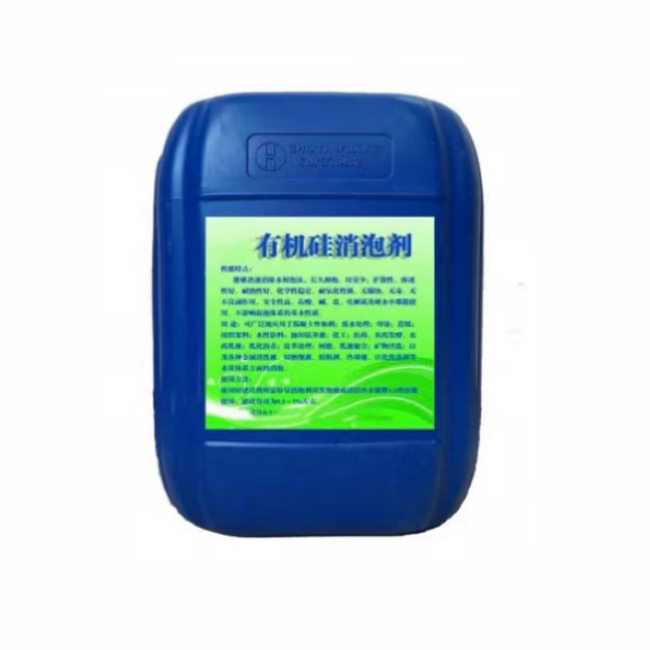

Silicone defoamer
The form of defoamer can be divided into oil type, solution type, emulsion type, powder type and composite type; according to the composition of defoamer can be divided into polyether type, organic silicon type, non-silicon type and silicate mixed type.
- Product Description
- Specification
Product Description
The form of defoamer can be divided into oil type, solution type, emulsion type, powder type and composite type; according to the composition of defoamer can be divided into polyether type, organic silicon type, non-silicon type and silicate mixed type.
I. Characteristics of Silicone Defoaming Agent:
1. Strong defoaming and foaming inhibiting force, less dosage, does not affect the basic properties of the foaming system.
2. Good heat resistance, chemical stability, no corrosion, non-toxic, no adverse side effects, non-combustible, non-explosion.
3. Its performance can be comparable to imported products, and the price has obvious advantages. Silicone antifoaming agents are widely used because of the following
characteristics:
① Low surface tension, high surface activity, strong defoaming force. With positive spreading coefficient, it can spread rapidly on the gas-liquid interface in the foaming system:
② Good thermal stability, low volatility. This ensures that silicone oil defoaming agent can be used in a wide range of temperature;
③ Good chemical stability. Due to the stable combination of Si-0 chain and Si-C chain, the chemical inertness of silicone is good, it is difficult to react with other substances, can be used in harsh conditions;
④ Non-toxic. Generally used as a defoamer, dimethyl silicone oil polymerization degree is high,
II. Scope of Application:
physicochemical indexes :
1. Textile slurry, high temperature dyeing;
2.industrial water conditioning ;
3. Mud defoaming in petroleum extraction;
4. Water-based coatings and other water-based foams.
5. Other industries that require time to suppress bubbles and fast to eliminate bubbles.
III. Bubble Machine Theory:
Defoaming is the reverse process of foam stabilization. Silicone defoaming agents generally have the following two functions to achieve the purpose of eliminating foam:
Silicone-based defoamers demonstrate exceptional spreading performance on foam liquid films, rapidly dispersing across foam surfaces to form a thin dual-layer structure. During diffusion and expansion, the low-surface-tension molecules displace stabilizing surfactant molecules from the film's surface.
This process reduces localized surface tension on foam walls, disrupting the foam's self-healing mechanism and ultimately causing foam rupture.
Second, when the silicone defoamer is dispersed in the foaming liquid, its molecules may be inserted into the wall of the foam liquid to form a mixed liquid wall. The structure of the mixed liquid wall is not uniform, resulting in poor cohesion and decreased local viscosity, which also causes the rupture of the foam.
Types and properties of silicone defoamers
There are dozens of kinds of silicone defoaming agents, which can be generally divided into silicone oil type, solution type, emulsion type, solid type and polyether modified type.
2 1 Silicone oil type organic silicon defoamer
① It is generally prepared from dimethyl silicone oil or dimethyl silicone oil and additives such as silica.
② It is suitable for defoaming oil soluble solutions and has little effect on the foam produced by aqueous solutions.
③ Generally, the low viscosity silicone oil type defoamer has fast defoaming effect but poor persistence; the high viscosity silicone oil type defoamer has slow defoaming effect but good persistence.
④ According to the properties of foaming oil solution, the principle of selecting silicone oil organic silicon defoamer is: the lower the viscosity of foaming liquid, the higher the viscosity of the selected silicone oil should be, and the higher the viscosity of foaming liquid, the lower the viscosity of the selected silicone oil should be.
2.2 Silicone oil solution type organic silicon defoaming agent
① It can be made by dissolving dimethyl silicone oil in a suitable solvent.
② Defoaming operation of oil-soluble solution: silicone defoamer prepared with organic solvents such as polychloroethane, toluene, xylene, etc.; Defoaming operation of water solution: silicone defoamer prepared with organic solvents such as hexanediol, glycerol and other water-soluble organic solvents.
③ The preparation process is very simple and convenient to use.
④ Silicone oil is dispersed in the foaming liquid with organic solvents to play a role in defoaming, and some solvents also play a certain role in defoaming during the diffusion process. However, this method is not widely used, mainly because the large use of organic solvents will increase the cost of defoaming agents and cause environmental pollution.
Specification
| Surface | White liquid |
| PH price | 6.0~7.5 |
| Solid content,% | 20.2 |
| Stability. (3 0 0 0 revolutions per 2 0 minutes) | Non-divisional |
| Foaming performance, s | 9 |

We'd love to hear from you.
Please leave a message, we will get in touch with you as soon as possible!











 Home
Home






